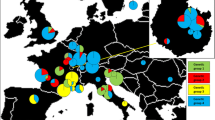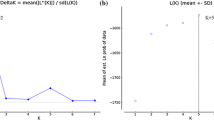Abstract
The aim of our study was to examine the genetic variation within Tuber aestivum on the Baltic island of Gotland, Sweden. Variation in such a limited geographical area should help illuminate the dispersal abilities of T. aestivum. Knowledge of the genetic variation in this northern outpost could also be useful in the selection of inoculum for the establishment of truffle orchards. Genetic structure and homogeneity of the population were studied using principal component and parsimony analyses of randomly amplified polymorphic DNA data. Our inventories showed that T. aestivum is abundantly distributed in suitable habitats on Gotland. The genetic variation observed suggests sexual reproduction and slow dispersal on the island. It is possible that the present population was established from one introduction, which may be due to ability to survive in this habitat rather than to rare colonising events. The T. aestivum population on Gotland may be an ecotype adapted to the climate and soil conditions on the island.


Similar content being viewed by others
References
Bertault G, Raymond M, Berthomieu A, Callot G, Fernandez D (1998) Trifling variation in truffles. Nature 394:734
Bohus Jensen E (1988) Om tryfflar på Gotland. Rindi 8:15–18
Chatin AD (1887) Une novelle espèce de truffe. C R Acad Sci 104:1132
Chevalier G, Frochot H (1997) La truffe de Bourgogne. Pétrarque, Levallois-Perret, France
Danell E (1994) Cantharellus cibarius: mycorrhiza formation and ecology. PhD thesis, University of Uppsala, Sweden
Farris JS (1969) A successive approximations approach to character weighting. Syst Zool 18:374–385
Farris JS (1989) The retention index and the rescaled consistency index. Cladistics 5:417–419
Felsenstein J (1985) Confidence limits on phylogenies: an approach using the bootstrap. Evolution 39:783–791
Fitch WM (1971) Toward defining the course of evolution: minimum change for a specific tree topology. Syst Zool 20:406–416
Fredén C (1998) Berg och jord — Sveriges nationalatlas. Sveriges geologiska undersökning, Uppsala, Sweden
Gandeboeuf D, Dupré C, Roeckel-Drevet P, Nicolas P, Chevalier G (1997) Grouping and identification of Tuber species using RAPD markers. Can J Bot 75:36–45
Gardes M, Bruns TD (1993) ITS primers with enhanced specificity for Basidiomycetes: application to the identification of mycorrhizae and rusts. Mol Ecol 2:113–118
Guillemaud T, Raymond M, Callot G, Cleyet-Marel J-C, Fernandez D (1996) Variability of nuclear mitochondrial ribosomal DNA of a truffle species (Tuber aestivum). Mycol Res 100:547–550
Kluge AG, Farris JS (1969) Quantitative phyletics and the evolution of the anurans. Syst Zool 18:1-32
Linnaeus C (1742) Carl Linnaeus öländska och gotländska resa år 1741. Wahlström and Widstrand, Stockholm, Sweden (1991)
McCune B, Mefford MJ (1999) Multivariate analysis of ecological data, version 4. MjM Software Design, Gleneden Beach, Ore, USA
Mello A, Cantisani A, Vizzini A, Bonfante P (2002) Genetic variability of Tuber uncinatum and its relatedness to other black truffles. Environ Microbiol 4:584–594
Miller SL (1985) Rodent pellets as ectomycorrhizal inoculum for two Tuber spp. In: Molina R (ed) Proceedings of the 6th North American Conference on Mycorrhizae, 25–29 June 1984, Corvallis, Ore, USA
Montecchi A, Sarasini M (2000) Funghi ipogei d’Europa. Associazione Micologica Bresadola, Trento, Italy
Pacioni G, Pomponi G (1991) Genotypic patterns of some Italian populations of the Tuber aestivum-T. mesentericum complex. Mycotaxon 42:171–179
Pacioni G, Frizzi G, Miranda M, Visca C (1993) Genetics of a Tuber aestivum population (Ascomycotina, Tuberales). Mycotaxon 47:93–100
Påhlsson I (1977) A standard pollen diagram from the Lojsta area of Central Gotland. Striae 3, Societas Upsaliensis Pro Geologia Quarternaria, Uppsala, Sweden
Redecker D, Szaro TM, Bowman RJ, Bruns TD (2001) Small genets of Lactarius xanthogalactus, Russula cremoricolor and Amanita francheti in late-stage ectomycorrhizal successions. Mol Ecol 10:1025–1034
Selosse MA, Martin F, Le Tacon F (1998) Survival of an introduced ectomycorrhizal Laccaria bicolor strain in a European forest plantation monitored by mitochondrial ribosomal DNA analysis. New Phytol 140:753–761
Swofford DL (2002) PAUP. Phylogenetic analysis using parsimony (and other methods), version 4. Sinauer, Sunderland, Mass, USA
Tommerup IC, Barton JE, O’Brien PA (1995) Reliability of RAPD fingerprinting of three basidiomycete fungi, Laccaria, Hydnangium and Rhizoctonia. Mycol Res 99:179–186
Trappe JM (1988) Use of truffles and false truffles around the world. In: Bencivenga M, Granetti B (eds) Atti del Secondo Congresso Internazionale sul Tartufo. Comunità montana dei monti martani e del serano, Spoleto, Italy, pp 19–30
Trappe JM, Castellano MA (1991) Keys to the genera of truffles (Ascomycetes). McIlvainea 10: 47–65
Trappe J, Castellano M, Claridge A (2001) Continental drift, climate, mycophagy and the biogeography of the hypogeous fungi. In: Fédération Française des Trufficulteurs. Actes du Ve Congrès International Science et Culture de la Truffe, 4–6 March 1999, Aix-en-Provence, France
Vittadini C (1831) Monographia tuberacearum. France
Wedén C, Danell E (1998) Tuber aestivum and other truffles in Sweden. Sven Bot Tidskr 92:65–80
Wedén C, Ericsson L, Danell E (2001) Research on Tuber aestivum syn. T. uncinatum, and T. mesentericum reported from Sweden for the first time. Sven Bot Tidskr 95:205–211
Acknowledgements
We would like to extend our gratitude to Elsa Bohus-Jensen, Gérard Chevalier, Michel Jalade, Pierre and Marcelle Poinsot, Olle Persson and landowners on Gotland for essential help with the truffle inventories. We thank Francis Martin for sharing his RAPD knowledge and primers, Inez Tommerup for kindly commenting on our manuscript and Dominique Delage, head of the truffle museum “L’écomusée de la truffe”, Sorges, France, for making the truffle blind test. We also wish to thank Bertil Widbom at Gotland University College for valuable support. This study was financed by the Municipality of Gotland, the Gotland County Administration, the European Agriculture Guidance and Guarantee Fund under the Objective 5b Gotland Programme and the European Regional Development Fund under the Objective 2 Islands Programme, and further supported by the KK Foundation (Kunskaps- och kompetensutvecklingsstiftelsen), Carl the XVI Gustafs 50th Anniversary Fund and Carl Tryggers Foundation.
Author information
Authors and Affiliations
Corresponding author
Rights and permissions
About this article
Cite this article
Wedén, C., Danell, E., Camacho, F.J. et al. The population of the hypogeous fungus Tuber aestivum syn. T. uncinatum on the island of Gotland. Mycorrhiza 14, 19–23 (2004). https://doi.org/10.1007/s00572-003-0271-4
Received:
Accepted:
Published:
Issue Date:
DOI: https://doi.org/10.1007/s00572-003-0271-4




